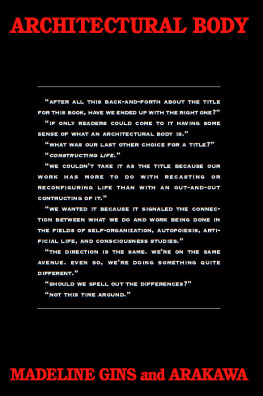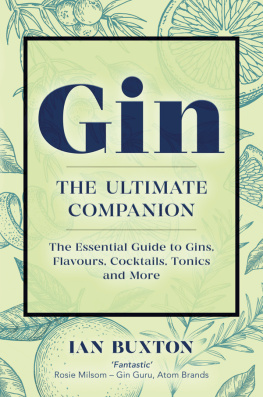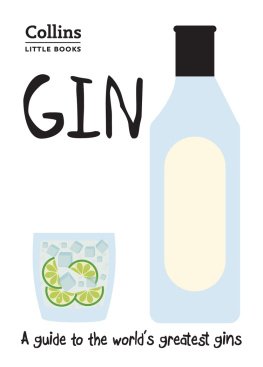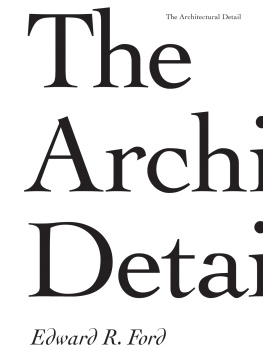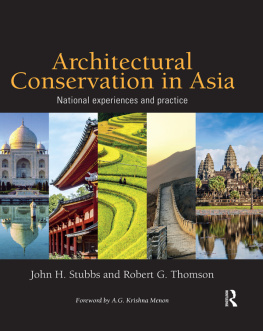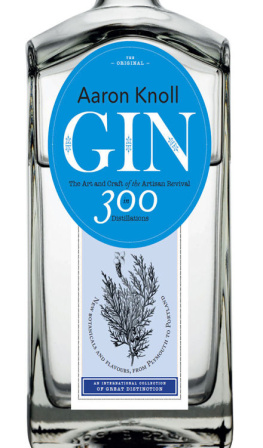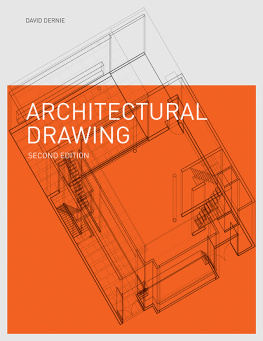Gins - Architectural Body
Here you can read online Gins - Architectural Body full text of the book (entire story) in english for free. Download pdf and epub, get meaning, cover and reviews about this ebook. year: 2012, publisher: University of Alabama Press, genre: Romance novel. Description of the work, (preface) as well as reviews are available. Best literature library LitArk.com created for fans of good reading and offers a wide selection of genres:
Romance novel
Science fiction
Adventure
Detective
Science
History
Home and family
Prose
Art
Politics
Computer
Non-fiction
Religion
Business
Children
Humor
Choose a favorite category and find really read worthwhile books. Enjoy immersion in the world of imagination, feel the emotions of the characters or learn something new for yourself, make an fascinating discovery.
Architectural Body: summary, description and annotation
We offer to read an annotation, description, summary or preface (depends on what the author of the book "Architectural Body" wrote himself). If you haven't found the necessary information about the book — write in the comments, we will try to find it.
Architectural Body — read online for free the complete book (whole text) full work
Below is the text of the book, divided by pages. System saving the place of the last page read, allows you to conveniently read the book "Architectural Body" online for free, without having to search again every time where you left off. Put a bookmark, and you can go to the page where you finished reading at any time.
Font size:
Interval:
Bookmark:
For the last forty years, artists-architects-poets Madeline Gins and Arakawa have created a visionary and widely admired body of workmuseum installations, landscape and park commissions, experimental texts and films, residential and office designs, philosophical treatises and artistic manifestosthat challenge traditional notions about our built environments and the ways we inhabit them. Their transformations of physical space have consistently explored the poetics of architecture and the nature of contemporary life and thought.
Since 1981, with the inception of their theory of reversible destiny the belief that through radical forms of architecture mortality itself can be undonethey have dedicated themselves to rethinking the relationships between architectural environments and the body.
In 1997 the Guggenheim Museum presented a retrospective of Arakawa and Gins's collaborative work, which received the College Art Association's highest award for that year (the Artist Award for Exhibition of the Year: Distinguished Body of Work, Presentation or Performance Award), and published a widely acclaimed catalogue of their work titled Reversible Destiny: WeDestiny ( We Have Decided Not to Die). Additionally, their work has been the subject of many critical studies by, among others, Jean-Franois Lyotard, Arthur Danto, Italo Calvino, George Lakoff, and Hans-Georg Gadamer. Their more recent projects include Nagi's Ryanji, a thirty-foot-diameter tube having both left-right and above-below symmetry, and The Site of Reversible Destiny, a seven-acre park. Currently, two projects based on the design principles outlined in the present text are under way: construction has begun on Bioscleave House, a private dwelling commissioned by a family in East Hampton, New York, and schematic drawings have been completed and delivered for Reversible Destiny Eco-Housing Parka reversible destiny community of several hundred units.
Books by Arakawa and Gins
Mechanismus der Bedeutung (The Mechanism of Meaning). Trans. Carlo Huber. 1st ed. Munich: Bruckmann, 1971. Introduction by Lawrence Alloway.
For Example (A Critique of Never). Trans. Aldo Tagliaferri. Milan: Alessandra Castelli, 1974.
The Mechanism of Meaning, 2nd ed. New York: Harry N. Abrams, 1979. Published in French as Le Mcanisme du sens. Trans. Serge Gavronsky. Paris: Maeght Editeur, 1979. Trans. Shuzo Takiguchi and Kiichiro Hayashi. Published in Japanese as exhibition catalog. Osaka: National Museum of Art, 1979.
Pour ne pas mourir/To Not to Die. Trans. Franois Rosso. Paris: Editions de la Difference, 1987. Published in Japanese. Trans. Masashi Miura. Tokyo: Libroport, 1988.
The Mechanism of Meaning, 3rd ed. New York: Abbeville, 1988. Published in Japanese in two volumes. Tokyo: Seibu Museum of Art and Libroport, 1988.
ARCHITECTURE: Sites of Reversible Destiny (Architectural Experiments after Auschwitz-Hiroshima.) London: Academy Editions, 1994.
Reversible Destiny. New York: Guggenheim Museum/Abrams, Inc., 1997.
Books by Madeline Gins
Word Rain or A Discursive Introduction to the Intimate Philosophical Investigations of G,R,E,T, A G,A,R,B,O, It Says. New York: Grossman, 1969.
Intend. Bologna: Tau/ma, 1973.
What the President Will Say and Do!! Barrytown, NY: Station Hill, 1984.
Helen Keller or Arakawa. Santa Fe: Burning Books; New York: East-West Cultural Studies, 1994.
Born into a new territory, and that territory is myself as organism. There is no place to go but here. Each organism that persons finds the new territory that is itself, and, having found it, adjusts it. This is so only if systematically organized events, fields in which relations among events have some degree of order, can count as territories. An organism-person-environment has given birth to an organism-person-environment.
The organism we are speaking of persons the world; other types of organisms dog, giraffe, or cockroach the world. While members of lower species routinely produce behavior that is true to type, the organism that persons, not always able to summon up all it must to produce a person, has a higher probability of failure. Various instances of an organism's having behaved as a person, many in succession, sum up as a person. It may seem that an organism has a person with which it is associated, but rather than actually having a person, an organism has a long-term association only with behaving as a person. Who has been accepted as a person by other persons is really nothing more than the set of ways an organism that persons behaves.
The momentum an organism is able to gain on being a person, or rather, on behaving as onethat set of conditions, born of actions taken, that makes person-formation possibledepends directly on how it positions its body. Surroundings invite, provoke, and entice persons to perform actions, and the enacting motions of these actions not only serve up alternate vantage points but also inevitably shift sense organs about. The shifting about of the sense organs naturally affects how a person fields her surroundings and has much to do with what of the surroundings ends up standing for or approximating the surroundings.
This that is Ian organism behaving as a personascribes. I do so ascribe. Organisms deploy; (organisms behaving as) persons ascribe. Not enough information on what obtains between organism and person has been collected, and the ebb and flow of each entity of this dynamic two-in-one duo remains uncharted. Any term that purports to reveal the dynamics of person formation but which fails to suggest the body's intricate relation to the environment muddies the view. Terms such as ego, consciousness, and psyche, losing the body as they do, lack those air passages through which the body draws in atmospheric wherewithal.
Close observations have yet to be made of the effect of type of habitation on persons. Those who would minutely observe the effect of habitation on human beings must begin to discern how and why surroundings give or withhold from organisms of the type that can person the means to behave as persons. Even as the concept of person can stay put (everyone knows what a person is), it needs to be greatly dilated (particularly within a book entitled Architectural Body). We have adopted the admittedly clumsy term organism that persons because it portrays persons as being intermittent and transitory outcomes of coordinated forming rather than honest-to-goodness entities; now that we have launched the term, we use the following less cumbersome terms synonymously with it: body, body proper, human being, organism, organism-person, person. When studying what goes on between the body proper and its surroundings, it will be necessary to consider the extent to which persons are behavioral subsets of the organisms from which they emanate and out of which they compose themselves as agents of action. The organism that persons is the first step on the path to the architectural body. Or neonates come equipped with set-to-go architectural bodies that their first movements activate and help shapeeach newborn organism-person-environment an Atlas shouldering the world in its entirety. The toddler, taking its first steps as an organism that persons, drags its whole world along as pull toy (architectural body).
Although finding where organism leaves off and person begins would seem an impossible task, keeping the question starkly unresolved will most likely provide the best view of what is in play. With less glossing and less generalizing going on, there are increases in both overall tentativeness of the situation and in a free-ranging on-the-spot observing that leads to direct mapping. Good scout that a human being is, ever bent on making do, on glossing interrupted melodies into tunes, she takes scattered moments of an organism's (herself ) behaving as a person and smooths them into a whole, herself. D. W. Winnicott's principle of good enough holds not only for mothers (according to Winnicott, any mother who is genuinely able to be there for her baby is a good enough mother) but also for persons (as we see it, any organism that genuinely exhibits person behavior is a good enough person).
Font size:
Interval:
Bookmark:
Similar books «Architectural Body»
Look at similar books to Architectural Body. We have selected literature similar in name and meaning in the hope of providing readers with more options to find new, interesting, not yet read works.
Discussion, reviews of the book Architectural Body and just readers' own opinions. Leave your comments, write what you think about the work, its meaning or the main characters. Specify what exactly you liked and what you didn't like, and why you think so.

